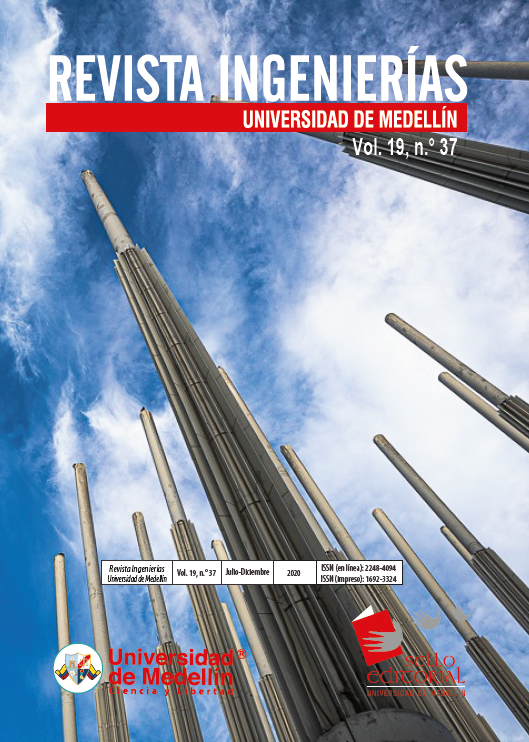Copyright (c) 2023 Revista Ingenierías Universidad de Medellín

This work is licensed under a Creative Commons Attribution-NonCommercial-NoDerivatives 4.0 International License.
- Articles
- Submitted: December 1, 2019
-
Published: March 18, 2020
Abstract
In this work, we numerically investigate the transport properties of two-dimensional square lattice patterns built from a telomeric DNA sequence, using an effective tight-binding model for the electronic structure, while the current is obtained within a Green’s function framework. We show that the self-assembled DNA structures based on telomeric DNA strands have current-voltage (I-V) characteristics, which make the system eligible for nanoelectronic applications.This paper shows a research on the transport properties of two-dimensional square lattice patterns built from a telomeric DNA sequence. A tight-binding model, and the recursive Green’s function method were used. It is showed that the self-assembled DNA structures based on telomeric DNA strands have current-voltage (I-V) characteristics, with robust plateau structures that favor the scrutiny of DNA-lead, as well as interference effects. An increase of the current, dependent on the distance between the crosses in the self-assembled square lattice structures, is observed, which makes the system eligible for nanoelectronic applications.
References
- [1] N. C. Seeman, and H. F. Sleiman, “DNA nanotechnology,” Nature Reviews Materials, vol. 3, p. 17068, 11 2018. DOI: 10.1038/natrevmats.2017.68.
- [2] N. C. Seeman, “DNA in a material world,” Nature, vol. 421, no. 6921, p. 427, 2003. DOI: 10.1038/nature01406.
- [3] G. M. Whitesides, and B. Grzybowski, “Self-assembly at all scales,” Science, vol. 295, no. 5564, pp. 2418–2421, 2002. DOI: 10.1126/science.1070821.
- [4] J. R McMillan et al., “Protein Materials Engineering with DNA” Acc. Chem. Res vol. 52, no. 7, p. 1939, 2019. DOI: 10.1021/acs.accounts.9b00165.
- [5] J. Nangreave, D. Han, Y. Liu, and H. Yan, “DNA origami: a history and current perspective,”Current Opinion in Chemical Biology, vol. 14, no. 5, p. 608, 2010. DOI: 10.1016/j.cbpa.2010.06.182.
- [6] A. Mangalum, M. Rahman, and M. L. Norton, “From DNA Nanotechnology to Material Systems Engineering” advanced materials, vol. 31, p. 1806294, 2019. DOI: 10.1002/adma.201806294.
- [7] J. Y. Kishi, T. E. Schaus, N. Gopalkrishnan, F. Xuan, and P. Yin, “Programmable autonomous synthesis of single-stranded DNA,” Nature Chemistry, vol. 10, p. 155, 2017. DOI: https://doi.org/10.1038/nchem.2872
- [8] X. Liu, F. Zhang, X. Jing, M. Pan, P. Liu, W. Li, B. Zhu, J. Li, H. Chen, L. Wang, J. Lin, Y. Liu, D. Zhao, H. Yan, and C. Fan, “Complex silica composite nanomaterials templated with DNA origami,” Nature, vol. 559, no. 7715, p. 593, 2018. DOI: https://doi.org/10.1038/s41586-018-0332-7
- [9] T. Lin, J. Yan, L. L. Ong, J. Robaszewski, H. D. Lu, Y. Mi, P. Yin, and B. Wei, “Hierarchical assembly of DNA nanostructures based on four-way toehold-mediated strand displacement,” Nano Letters, vol. 18, no. 8, p. 4791, 2018. DOI: https://doi.org/10.1021/acs.nanolett.8b01355
- [10] D. Y. Tam, X. Zhuang, S. W. Wong, and P. K. Lo, “Photoresponsive self-assembled DNA nanomaterials: Design, working principles, and applications,” Small, vol. 15, no. 26, p. 1805481, 2019. DOI: 10.1002/smll.201805481.
- [11] Y. Li, and R. Schulman, “DNA nanostructures that self-heal in serum,” Nano Letters, vol. 19, no. 6, p. 3751, 2019. DOI: 10.1021/acs.nanolett.9b00888.
- [12] C. Páez, and P. Schulz, “Electronic localization at mesoscopic length scales: different definitions of localization and contact effects in a heuristic DNA model,” Eur. Phys. J. B, vol. 86, p. 104, 2013. DOI: 10.1140/epjb/e2013-30728-9.
- [13] R. Gutiérrez, S. Mandal, and G. Cuniberti, “Quantum transport through a DNA wire in a dissipative environment,” Nano Letters, vol. 5, no. 6, p. 1093, 2005. DOI: 10.1021/nl050623g.
- [14] C. J. Páez, and P. A. Schulz, “Delocalization of vibrational normal modes in double chains: Application to DNA systems,” Microelectronics Journal, vol. 39, no. 11, p. 1222, 2008. DOI: 10.1016/j.mejo.2008.01.007.
- [15] C. J. Páez, P. A. Schulz, N. R. Wilson, and R. A. Roemer, “Robust signatures in the current–voltage characteristics of DNA molecules oriented between two graphene nanoribbon electrodes,” New Journal of Physics, vol. 14, no. 9, p. 093049, 2012. DOI: 10.1088%2F1367-2630%2F14%2F9%2F093049.
- [16] C.-T. Shih, S. Roche, and R. Roemer, “Point-mutation effects on charge-transport properties f the tumor-suppressor gene p 53,” Physical review letters, vol. 100, p. 018105, 02 2008.
- DOI: 10.1103/PhysRevLett.100.018105.
- [17] C. J. P´aez, R. Rey-Gonz´alez, and P. A. Schulz, “Macroscopic localization lengths of vibrational normal modes in a heuristic DNA model,” Phys. Rev. B, vol. 81, p. 024203, Jan 2010. DOI: 10.1103/PhysRevB.81.024203.
- [18] S. A. Wells, C.-T. Shih, and R. A. Römer, “Modelling charge transport in DNA using transfer matrices with diagonal terms,” vol. 23, p. 4138, 2009. DOI: 10.1142/S0217979209063328.
- [19] J. Rak, A. Voityuk, A. Márquez, and N. Rösch, “The effect of pyrimidine bases on the hole-transfer coupling in DNA,” vol. 106, no. 32, p. 7919, 2002. DOI: 10.1021/jp014261m.
- [20] M. P. L. Sancho, J. M. L. Sancho, J. M. L. Sancho, and J. Rubio, “Highly convergent schemes for the calculation of bulk and surface green functions,” Journal of Physics F: Metal Physics, vol. 15, no. 4, p. 851, 1985. DOI: 10.1088%2F0305-4608%2F15%2F4%2F009.
- [21] N. B. Larsen, H. Biebuyck, E. Delamarche, and B. Michel, “Order in microcontact printed self-assembled monolayers,” Journal of the American Chemical Society, vol. 119, no. 13, p. 3017, 1997. DOI: 10.1021/ja964090c.
- [22] D. Porath, A. Bezryadin, S. De Vries, and C. Dekker, “Direct measurement of electrical transport through DNA molecules,” vol. 403, p. 635, 2000. DOI: 10.1038/35001029.
- [23] H. Cohen, C. Nogues, R. Naaman, and D. Porath, “Direct measurement of electrical transport through single DNA molecules of complex sequence,” vol. 102, p. 11589, 2005. DOI: 10.1073/pnas.0505272102.
- [24] C. Lewenkopf, and E. Mucciolo, “The recursive green’s function method for graphene,” Journal of Computational Electronics, vol. 12, no. 203, p. 203, 2013. DOI: 10.1007/s10825-013-0458-7.


















